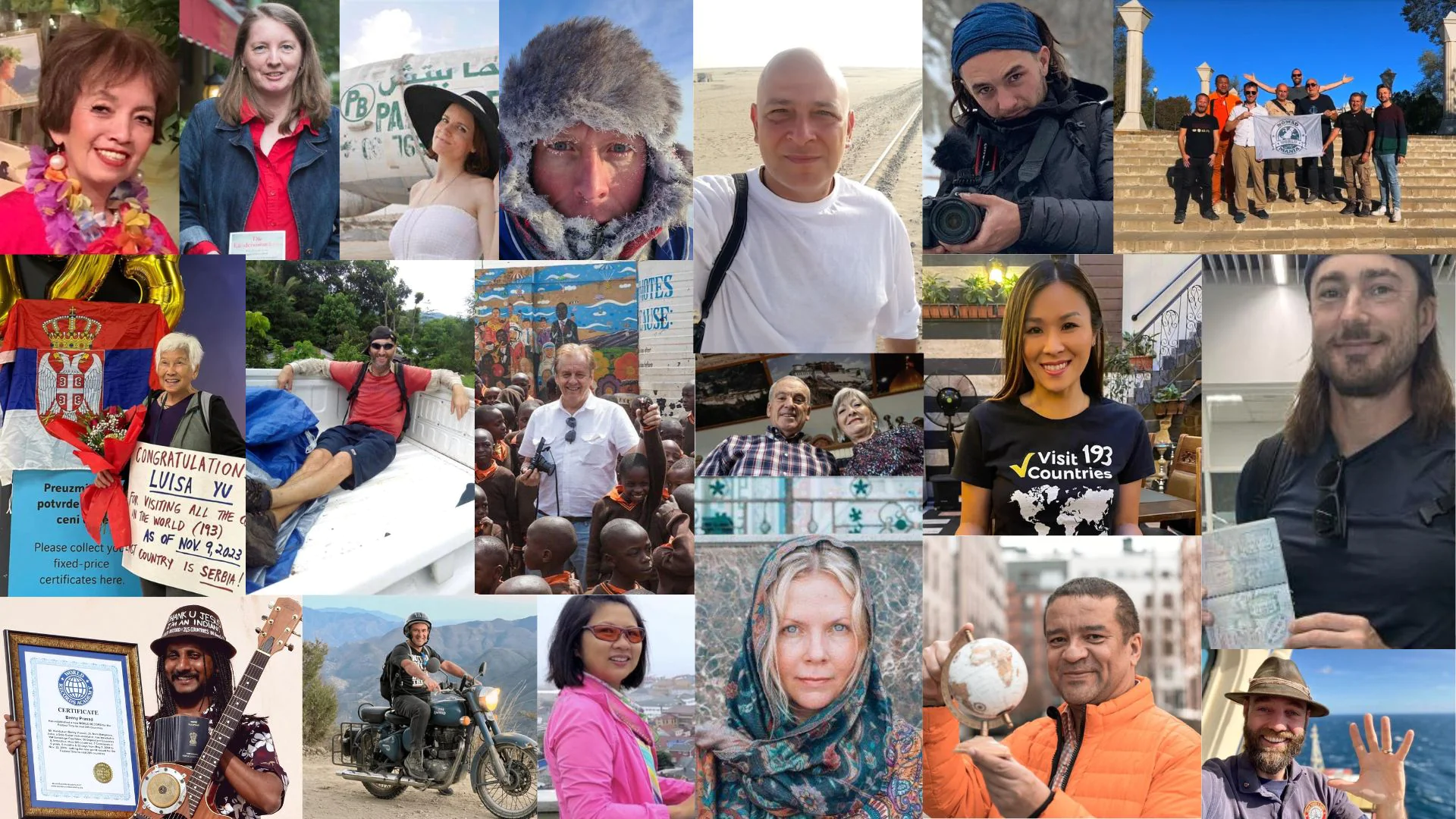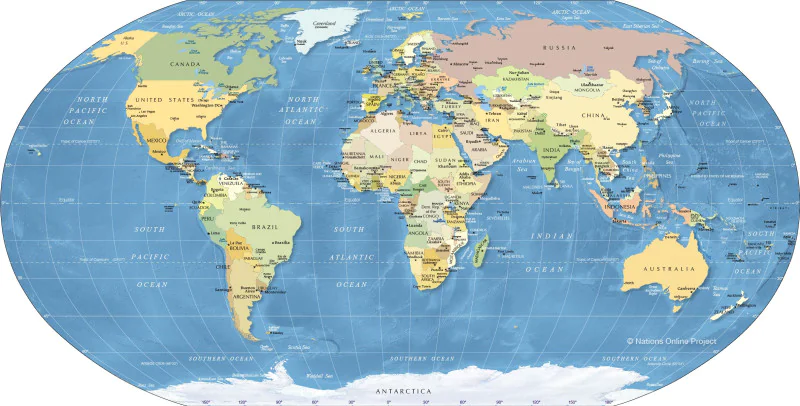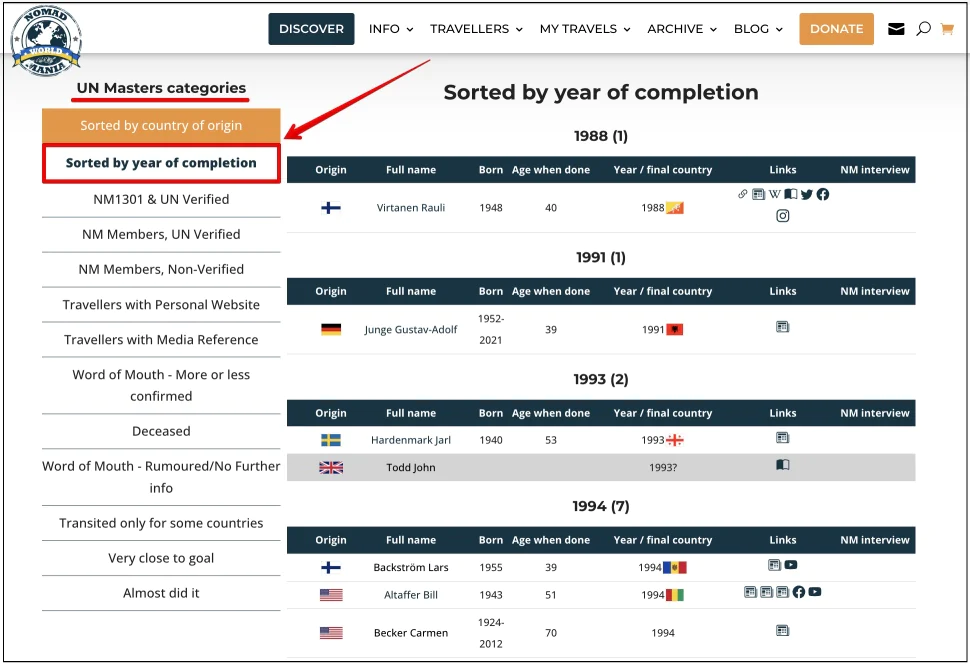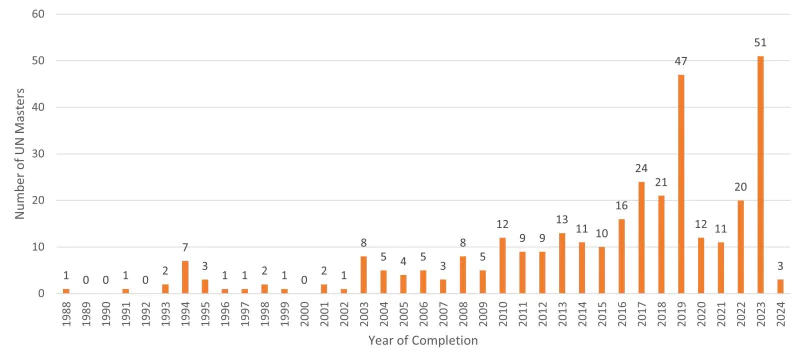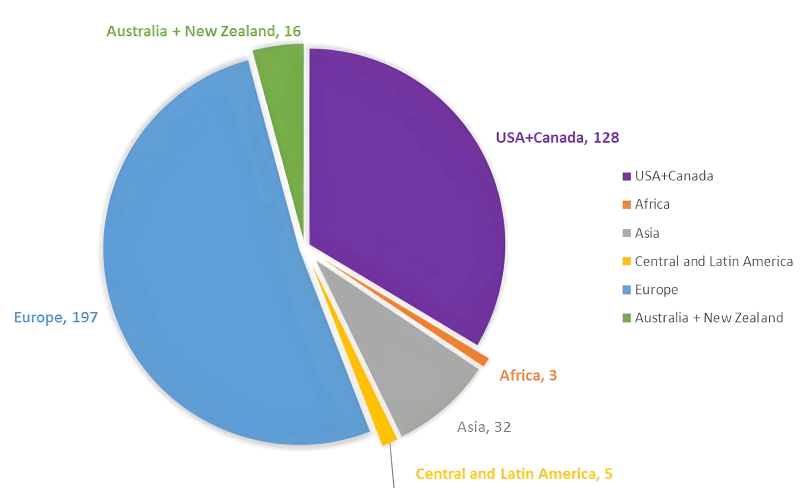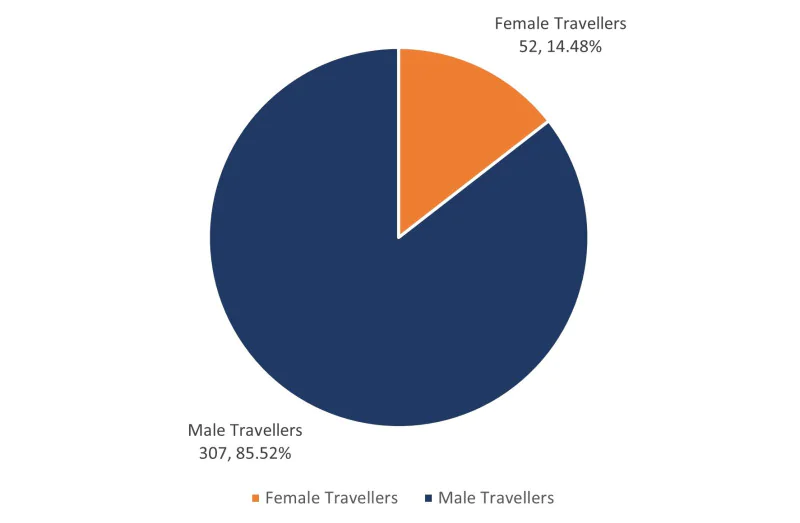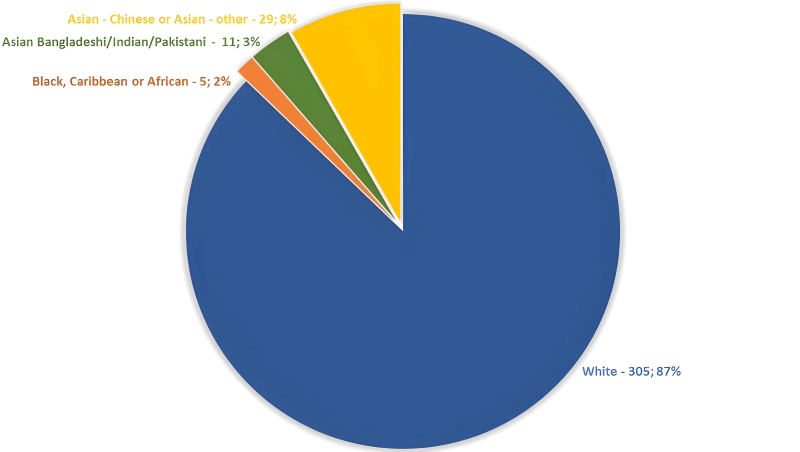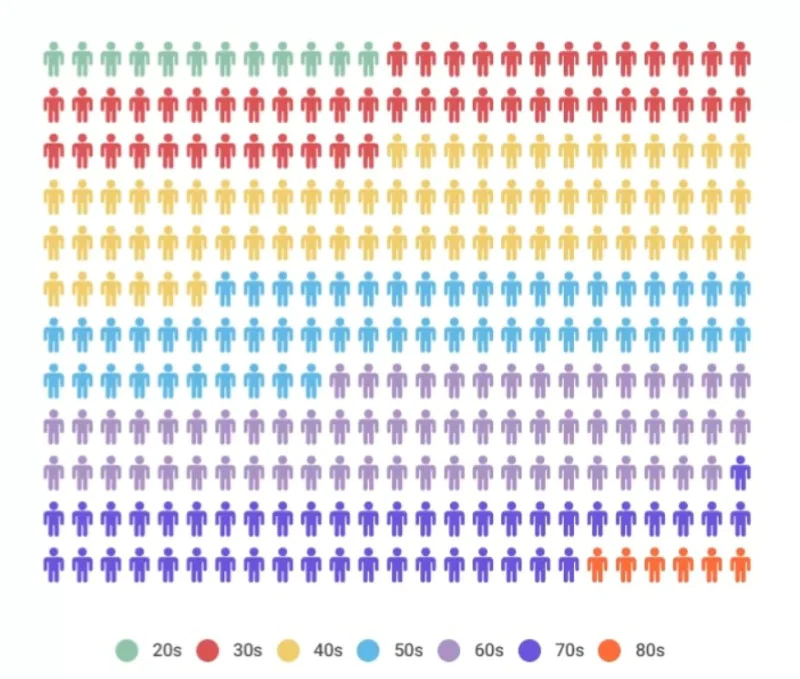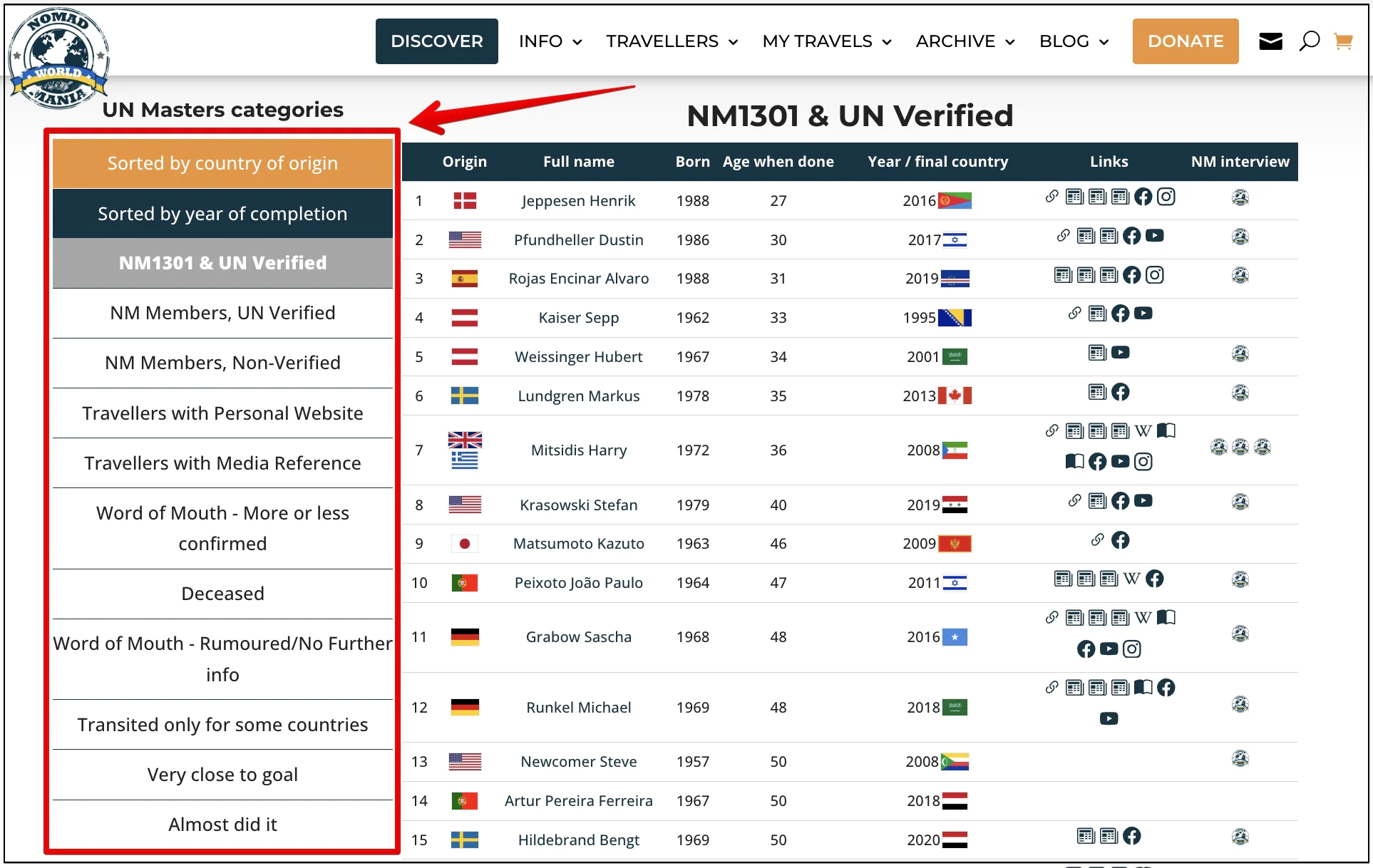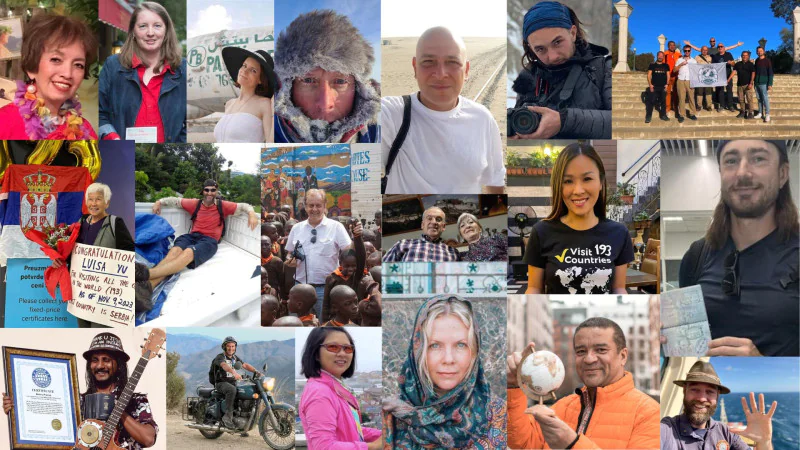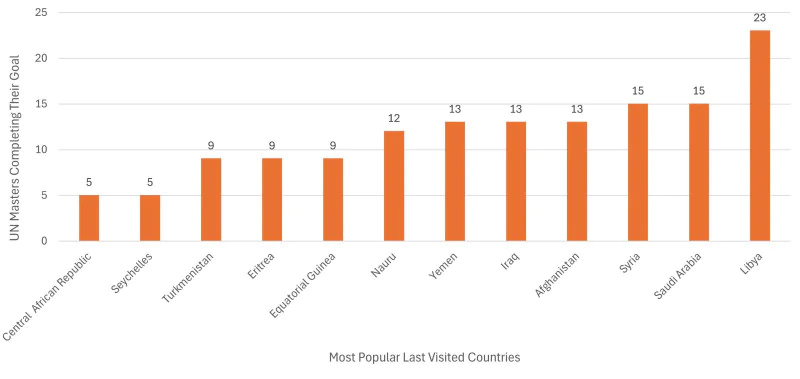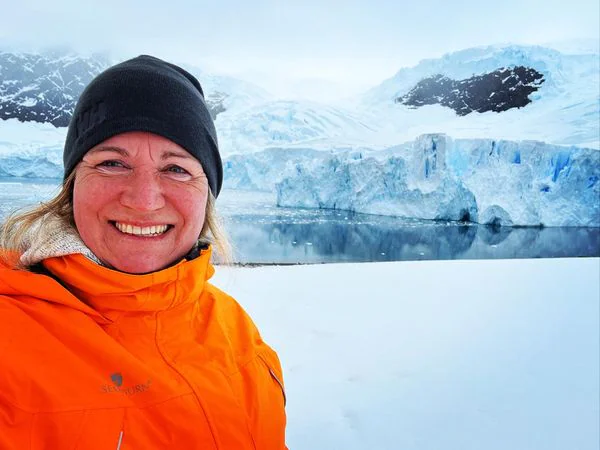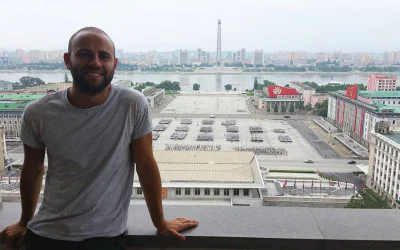Have you ever wondered who the people who visited every country are?
The concept of travel and ‘seeing the whole world’ is clearly not new. The Greek traveller and geographer Pausanias, who lived in the 2nd century AD, is perhaps considered one of the first travel writers. Through his opus ‘Description of Greece’, he aimed to travel far and wide to complete his findings. The desire to ‘go everywhere’ may have been there, but before the modern era, there were obvious limitations in transport. A very small percentage of people could afford to travel anyway. So, even big travellers of their day were often confined to a couple of continents at best. Even a book like Jules Verne’s Around the World in 80 Days only takes in 11 of today’s countries, we believe.
The Travelers’ Century Club (TCC) was founded in 1954, yet none of its initial members visited every country. A few sovereign countries were ‘closed’ for a long time, among them Albania, Bhutan and DPRK (North Korea). Only diplomats or government representatives could attempt visits there and we assume even those could be cumbersome.
Based on our information, the first person who can legitimately claim to have been to every country – as the countries stood at the time – is Finnish journalist and writer Rauli Virtanen (recipient of NomadMania’s Lifetime Achievement in Travel Award 2023). Rauli visited his last country, Bhutan, in 1988 at the age of 40.
Rauli Virtanen 🇫🇮, probably the first person to visit every country in the world

The concept of ‘Visiting Every Country’
We must remember that the idea of visiting every country is by no means fixed. In 1939, there were only 73 sovereign countries; by 1959, there were around 20 more; and then in the 1960s there was an explosion of ‘new’ countries; by 1972, we can count 148 countries.
Political Map of the World. Map source: Nations Online
As recently as 1950, only 4 countries in Africa were independent, compared to today’s 54. The independence of a few Caribbean and Pacific states in the late 1970s and 1980s drove numbers up. As did the collapse of the Soviet Union and Yugoslavia in the early 1990s. But there seem to be very few ‘new’ countries after 1994 – only 3 newly independent ones in the UN.
For our analysis below, we are taking the current 193 United Nations (UN) members as constituting ‘every country.’ We accept those who visited every country according to the countries at the time of completion as having achieved it.
Of course, some people use other standards to define ‘every country’ but the 193 is indisputable and the least problematic. Especially as clearly sovereign, universally recognised countries not in the UN before, like Switzerland or Tuvalu, joined at the start of this century.
Lucy Hsu 🇺🇸
Independence of Countries
In the period since the early 20th century, countries gained independence frequently. The longest interval since 1898, when the Philippines achieved their sovereignty, was 11 years between 1932 (Iraq) and 1943 (Lebanon). Until now, that is.
The current period of 13 years since South Sudan’s independence in 2011 is the longest without a ‘new country’ since the end of the 19th century. That’s the longest in more than 125 years. It doesn’t look like a ‘new’ one is coming up before 2027 at best. For many, the creation of a new internationally recognised sovereign country will be really big news.
We believe this is the most detailed report ever composed on the subject of Visiting Every Country. We will look at some of the interesting statistics around this. How many we believe have done it, what is their general profile in terms of nationality, age, gender and ethnicity. And as an interesting bonus, which countries are generally left last.
Throughout January 2024, we ran a Poll about your views on visiting every country… Read the results here!
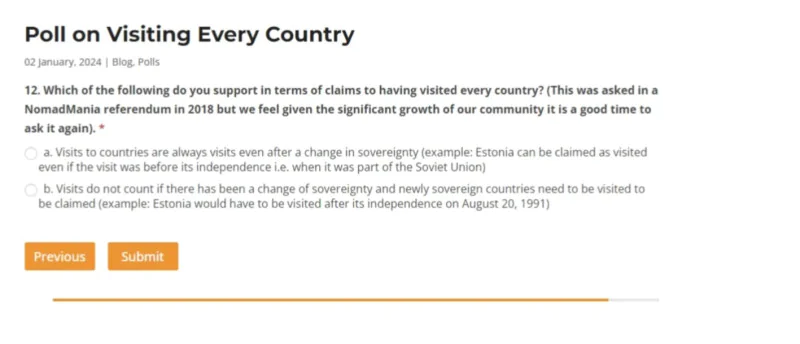
History of Visiting Every Country
Following Rauli Virtanen in 1988, the 1990s saw more interest in visiting every country. By the dawn of the Millennium, we can count almost 20 people who have achieved this. Many of these travellers were members of the TCC, so the majority were from the United States.
Until 2008, we have 55 people and the variation in nationalities grows – we count 16 nationalities. Still, 62% are white, male and above the age of 50; 91% are white and male. In each of the years until 2010, far less than 10 people that we know of complete per year. There are a few ‘spikes’ in 2003 and 2008, when more than 5 achieve what is then 191 or 192.
The increase begins in earnest in 2010, which was a record for the time, with 12 people reaching 192. The following year South Sudan becomes independent and joins the UN, so we can really talk of 193. We note an average of around 10 UN Masters per year after that. But then, in 2016, we see an increase to 16. This is followed by a leap to a massive 47 people completing a visit of all of the world’s 193 UN countries in 2019.
In 2020, the year the pandemic spread, we only find 12 people completing it, the vast majority until mid-March of that year. The following year only 11 people achieved it, which is still an accomplishment given covid restrictions were in force. The numbers have bounced back significantly since then, and in 2023 we count at least 51 new UN Masters. Yes, ladies and gentlemen, 2023 is officially the record year with the most UN Masters in history!
People Who Visited Every Country in The World by the Year of Competion
A further development is the aim of some to visit every country not just once, but twice. So far, we are aware of 3 travellers who have been confirmed to have visited every country twice. 3 more are actively aiming for this, including 80-year old Spaniard Juan Luis Galatas. He is only missing North Korea second time round. The first and so-far youngest traveller known to have achieved this ‘double’ is Norwegian Gunnar Garfors. The other two are Polish-Kenyan Slawek Muturi and Greek-British Harry Mitsidis.
Meanwhile, the mix in terms of ethnicities, ages and profiles is considerably more diverse than it was as recently as 2008; we will look at this in the next sections.
How Many People Visited Every Country? Part I
The inevitable question of ‘how many’ runs into a lot of obvious issues. To name a few:
- Many people are under the radar for various reasons i.e. privacy, not being particularly sociable or not on social media. They are not aware of travel communities like ours, or don’t want to be known, so we can’t reach them.
- We assume there must be more people in countries like China and especially Japan. Is there really nobody from South Korea? But they are difficult to track due to linguistic and cultural limitations.
- The eternal question of ‘what counts as a visit’ will lead to different interpretations of the number. Following our NomadMania polls on ‘what is a visit’ in 2022, strict standards were adopted. Visits to the DMZ as North Korea or the Golan Heights as Syria are rejected by the vast majority of the NomadMania community. Also not accepted are airport transits or putting a foot across a line.
.
However, both Guinness and the TCC have invariably accepted such visits in the past, it would seem. For this reason, we note people we know have claimed 193 in this way in a special rubric in our UN Masters list. Our general numbers are based on the claim itself rather than our interpretation of the claim.
Ultimately, if we include everyone we know of with a claim, we get a number of 357 people as of December 31, 2023. Even as we researched this report in the last 10 days of 2023, we celebrated two new UN Masters. Of this number of 357, approximately 30 are in the ‘transited’ rubric and around 25 are known to be deceased while almost 30 are in the ‘Word of Mouth’ rubric.
Ernestine Chan, who became a UN Master in the last days of December 2023
Let’s use the number of 350 as a base for the following sections and the statistics, and we’ll come back to this discussion after that.
People Who Visited Every Country by Nationality
The indisputable champion in terms of country of origin is the United States, with 119 people claiming 193; that’s a third of the total UN Masters.
Based on our data, we can count a total of 45 UN countries with at least one UN Master to represent them. That’s less than a quarter of the total number of countries.
If we compare the number of UN Masters with the overall population of the country in question, the true champion emerges and that is none other than Finland. With a population of approximately 5,545,000, Finland has 18 UN Masters, one for every 308,000 people. Compare this to the United States which has one for almost every 2.8 million. Or to Finland’s western neighbour Sweden, which has four more but almost double the population, and Norway, with a similar population and only 5 UN Masters that we know of. In general, the entire Nordic region is very well represented in UN Masters with a total of 50, more than 14% of the total.
Runners-up in terms of total number are Germany with 30 and the United Kingdom with 28 UN Masters. There is a surprising lack of UN Masters from France, where at best we have information on only 4 travellers – they obviously hide very well!
In Asia, China (including Hong Kong) and Japan are tied with 9. We believe our number for Japan is undercounted, while in China four of the people are foreign-born with other passports too.
The only representation from Africa is a lone citizen from South Africa (Angus Stenhouse), and citizens of Uganda (Jessica Nabongo) and Kenya (Slawek Muturi) who also have other passports and don’t live in Africa permanently.
In terms of Central and Latin America (including Mexico), Brazil has a notable 2 UN Masters (Anderson Do Vale and Paulo Mansur Raymundo); Colombia (Leon Hochman), Mexico (Magali Hinojosa) and Panama (Jaime Aleman) each have one, though we believe every one of them has a second passport.
Australia (10) and New Zealand (6) are also relatively ‘high’ in terms of numbers compared to their populations.
Nationalities of UN Masters, Sorted by Continent
Other Interesting Number Crunching
‘Developed’ countries which still do not have a UN Master that we know of include Chile, Croatia, Estonia, Israel, Slovenia and South Korea. The first person from the Middle East (not including Turkey) to make the claim, Reza Hashemiha, is originally from Iran but also holds US citizenship. In early 2024, we also see the first Arab UN Master, from Kuwait.
Looking at travellers from Low Passport Index (LPI) countries who do NOT have a second passport, at best we can identify only 7 UN Masters. This is probably the highest number, as we can’t know if among those someone has a second passport as well. This is less than 2% of the total number even though LPI countries represent exactly 50% of the entire number of countries and closer to 70% of the world’s population. We believe that the first LPI traveller to achieve the feat is Benny Prasad from India. The others are: Indian Kashi Samaddar and Ranjan Sharma, Chinese Ke Yin He, Zhang Lili and Huang Shihe and Kazakh Bolat Yerezhepov.
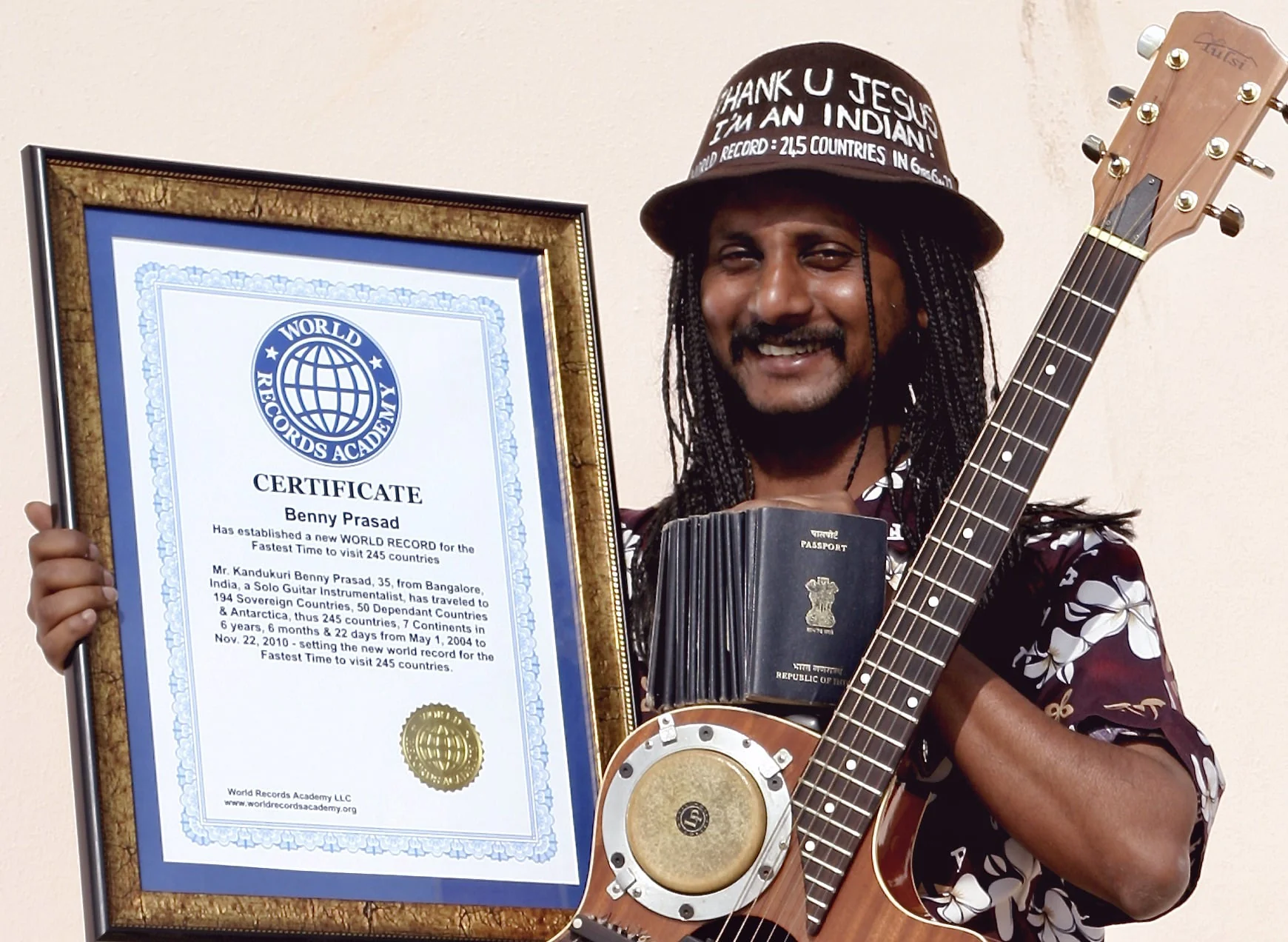
The biggest countries by population with no UN Masters claims are Indonesia (our lone claimant with that flag is in reality British) and Pakistan. Compare this to the smallest country by population with a UN Master, Iceland.
The biggest country in terms of territory with no claim to a UN Master is Algeria. The smallest in terms of territory with claims are Singapore and Cyprus.
Apart from small countries (Liechtenstein and Luxembourg), the highest ranked Human Development Index country where we don’t know of a UN Master is South Korea.
Gender of UN Masters
For the purposes of this exercise, as we don’t have any information on non-binary individuals, we will look at gender as male or female. Based on what information we have so far, we can find the following general numbers:
- 307 men claim to have visited 193 (85.5%);
- 52 women claim to have visited 193 (14.5%).
Gender Distribution of People Who Visited Every Country in The World
Of the above, 26 people did it as a couple, completing 193 together – of which 11 male-female couples, one same-sex (female) couple and one ‘couple’ of identical (male) twins. Despite reports of a Spanish-French family of 4 planning to do 193 coming from distant 2010, we can’t confirm this nor are we aware of any other family units or related individuals who have completed 193 together. We do know at least of one couple where both visited every country but not finishing at the same time and not necessarily travelling together for much of the route.
Women completing 193 in the earlier days until 2010 were generally as part of a couple and we believe the first one was Carmen Becker in 1994; Marian Speno may be the first ‘solo’ woman to make a claim and we believe she visited every country in 1998. Audrey Walsworth (2005) and Nina Sedano (2010) complete this early picture of solo women travellers in a very male-dominated UN Master environment.

Things have changed since then. Of a total of 52 claims by women, 30 – more than 57% – have been made since 2019. This points to the clear trend that, if in the first years women UN Masters were rare, this is no longer the case.
Comparing the above with the numbers for 2023, of the 50 new UN Masters on our list for 2023, 14 are female. This is the largest number of women to complete 193 in a single year based on our info. It also means that more than a fourth of the women who have ever done it, did it within 2023! This is still a male-dominated field, however women represent 28% of the total in 2023. This is almost double the average percentage of women UN Masters overall.
It is worth mentioning that women completed 193 first in Hungary, Latvia, Mexico and the Philippines: in the latter case, two women! Apart from Hungary, in the other countries there is no male UN Master that we know of.
Ethnicity of UN Masters
Ethnicity is a very complex issue whose definition is outside the scope of this analysis. We will deliberately oversimplify here just to illustrate a few trends and we ask for understanding for our oversimplifications. We also note that NomadMania does not collect ethnicity data, so we make our analysis based on some assumptions rather than on ethnicity statements by the people involved. We ask for understanding as without these, this section itself would be impossible to compose.
In terms of naming of ethnicities, we will apply the UK standard classification as used in the 2021 UK Census. There ‘White’ is used, as is ‘Black, Black British, Caribbean or African’, while ‘Asian’ is used with subcategories. These are classified as Asian – Bangladeshi/Indian/Pakistani, while further East, they are classified as Asian – Chinese or Asian – other. No offence please in case of a divergence in terminology in different areas of the world.
In general, we believe that, of approximately 350 UN Masters, around 45 are not white, which is less than 13%. If we subtract the numbers from China, Japan, Singapore and Taiwan, which we can loosely call ‘developed Asian economies,’ we remain with around 25 UN Masters, a little more than 7%.
Luisa Yu 🇵🇭
We believe there are (approximately):
- 5 Black, Caribbean or African UN Masters;
- 11 UN Masters with an Asian Bangladeshi/Indian/Pakistani background;
- Slightly less than 30 overall with an Asian – Chinese or Asian – other background not including the above.
z
Ethnicity Distribution of People Who Have Been to Every Country In The World
Of the 119 United States citizens claiming 193, we identify 12 to 15 who are not white to the best of our understanding, which is around 11% (compared to almost 41% not white population of the United States overall).
Age of UN Masters
At what age do people become UN Masters? This has also changed slightly over time, though not as noticeably as may be believed. The ages listed in NomadMania’s UN Masters List are the ages on the date the person claims to have visited 193 if known, This implies that a person who did it when they were 39 and 350 days old will be listed as 39 rather than 40. Otherwise, if dates of completion are not known, the age is based on the year of birth and the year of completion.
In general, we can perhaps divide age for this exercise into three categories:
- ‘The Fast and Furious’ (early 20s to early 30s)
- ‘Professionals or not’ (mid 30s to early 50s)
- ‘Life Purpose’ (mid 50s and above)
The average age of completion of 193 based on data for around 300 respondents is 53 years. Interestingly, we get the exact same average age when looking at the data of the female travellers alone. The average is higher for certain countries; for the United States it is 57; it is also 57 for Sweden (where we believe we have totally accurate data) and 56 for Finland. Conversely, it is lower for Italy and Russia with an average of 47 years, but the number of UN Masters we know of is much smaller.
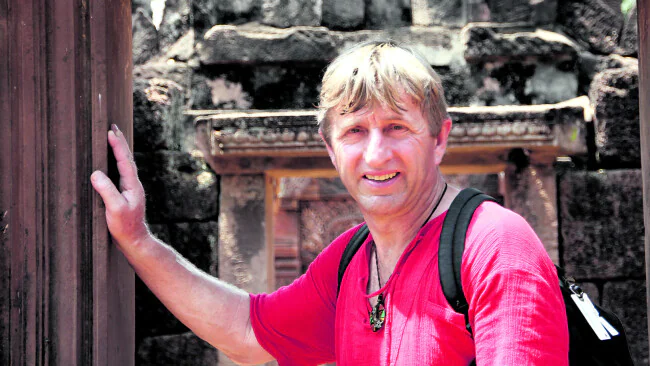
Initially, it was mainly the older group that completed 193, with some examples of the middle group as well. For many years, Kaiser Sepp from Austria could claim to be the youngest, as he completed the countries at the age of 33 in 1995; this was followed by Italy’s Maurizio Giuliano who did it at 28 in 2004, the first under the age of 30.
Since then, there has been a slight increase in the early completers, even if some of them are listed in our ‘transit’ category. But though they may get a lot of publicity, we can at best only identify around 25 UN Masters in the ‘Fast and Furious’ category i.e. aged 33 and under. This is little more than 7% of the total.
The numbers for the other two categories are currently almost even. ‘Professionals or not’ account for 131 of the total, while ‘Life Purpose’ (55 and above) make up 143 of the total; around 50 of these are older ‘completers’ above the age of 70.
If you’re observing that the numbers don’t quite add up to 350, that’s because we have quite a few gaps in our understanding of the age of completion for around 50 of the UN Masters; nevertheless, we believe most of these to be in the ‘Life Purpose’ category.
The general numbers of age of completion per decade of age are as follows:
- Travellers in their 20s: 12
- Travellers in their 30s: 50
- Travellers in their 40s: 69
- Travellers in their 50s: 54
- Travellers in their 60s: 64
- Travellers in their 70s: 45
- Travellers in their 80s: 6
Age of Achievement: Completion of Visiting Every Country by Decade of Life
We can conclude that visiting every country is, in the most part, something that is achieved overall after a person’s mid-30s, but that it is a myth that the majority are much older individuals. Generally, it would seem that in recent years many people decide on this and see it to fruition in their late 30s and 40s. Others, with a slower pace and other life commitments are more likely to complete later in life.
Looking at the data for 2023, we can see the following (2 with unknown age, but probably in ‘Life Purpose’):
- 4 in the ‘Fast and Furious’ age group
- 22 in the ‘Professionals or not’ age group
- 22 in the ‘Life Purpose’ age group
From 2020 to 2022, there are only 2 ‘Fast and Furious’ claims. There were 18 in the ‘Professionals or not’ age group and 27 ‘Life Purpose’. These more recent results are overall in line with the general trend.
General Profile of UN Masters
Neither NomadMania, nor any other organisation that we know of, gather specific information on ‘Visiting Every Country’ which could result in finding any commonalities. Our own experience suggests that UN Masters are extremely diverse in everything. From marital status to political opinions or sexual orientation to socioeconomic status and family background, there appear to be few common threads other than the obvious love of travel.
In terms of travel styles too, UN Masters appear to come in all guises. Some achieved the feat while travelling in groups or with agencies who took care of many details. Others are hardened individualists who attempt uncompromising solo adventures. Billionaires who fly on private jets, or those on meagre budgets who have succeeded through getting sponsored by large organisations – UN Masters come with wallets of different sizes too.
There’s those who are into extreme physical feats of endurance as well and those with full-time jobs travelling when they can. Some are very slow travellers who are clearly not ‘in a hurry,’ others reach 193 in a matter of a few years.
To illustrate the diversity of occupations, UN Master claims include: an internationally renowned singer, at least two flight attendants, a former tennis pro, the owner of a University, a plastic surgeon, some well-regarded academics, an electrics shop owner, a dentist, a dishwasher, a judge, a kindergarten teacher, a number of travel agents and travel industry professionals, government officials including some working for the UN or ambassadors, a real-estate mogul, a few top-rated journalists and many high-ranking business managers with years of experience in their field.
Conversely, and this is especially so for the younger UN Masters (but not only), some have turned their travels into their livelihood. For example, they offer/lead trips themselves based on their visibility in the travel world or turn into social media sensations and live off that. Some have authored books or are becoming motivational speakers/presenters with travel as a predominant theme.
All of the above leads to a basic understanding of the true diversity of UN Masters.
How Many People Visited Every Country? Part II
We return to this ‘thorny’ question and address it from a NomadMania perspective now.
Firstly, we believe that we must be ‘missing’ approximately 30% of those who have done it. This 30% may include those we have on our lists but we are not aware they have in fact completed 193. We think that often some media mention the feat or a traveller has acquaintances in the community. This leads us to information about them, and that implies they are ultimately included in the list.
We wish we got more help from the community itself!
Since its inception, we have divided our own UN Masters List into a number of categories which make sense to us. Obviously, NomadMania members get an advantage and are listed in the first 3 categories. First, those verified for both UN countries and regions; then, those verified for UN countries; and unverified in the third.
We then list travellers who are not NomadMania members but have their own websites and those who have a media reference. Based on these, there is a certain ‘legitimacy’ to the claim, unless we know otherwise.
We follow with those who we know to be deceased. Category 7 are those we have only heard have done it, or claim it in, for example, TCC archives. These have no other media reference and we have no way of communicating with them to corroborate.
We finally list those we believe claim it in a way that doesn’t satisfy NomadMania’s rules of a visit. These were expressed based on our community’s own perceptions. There are around 30 travellers in this category, some claiming more than 10 countries through quick airport transits, for example. We are not here to judge, but we want to be fair and consistent with our rules.
In any case, these travellers are legitimated by other organisations or the media. Some have made big claims about their travels that have garnered them global publicity. Therefore, they do earn their place in our UN Masters list overall.
Finally, we must note that we have a huge number of travellers who are almost there. 80 people that we know of – and here we are certainly missing many! – are less than 7 countries away from 193. Of these, more than 20 are only missing one country.
The Final Verdict
If we take all of the above into consideration, we can conclude the following:
The most ‘lenient’ number includes the estimated 30% we believe we don’t know about. This leads us to around 465 people having visited every country as of the end of 2023. By the end of January 2024, we already know of 3 more UN Masters!
On the other hand, taking the strictest number, we consider only those we know of with great certainty. We do not count those who have not visited 193 based on NomadMania rules. Or those who are just ‘hearsay’ and we truly can’t confirm, as we don’t know more about them. In this case, the number is around 295 people (including those deceased).
The lenient number means that there’s 1 UN Master in 17.4 million people.
The strict number, subtracting the 25 deceased, means that currently on earth there is 1 UN Master in 30 million.
So, strict or lenient, if you’re a UN Master – you’re much rarer than ‘one in a million.’
People who travelled to every country. Defined strictly, currently on earth there is 1 UN Master in 30 million people.
The Last UN Country
Since NomadMania does keep data on a UN Master’s last visited country, it is interesting to find trends in that. Which countries are generally chosen?
We have two different groups overall, with the overwhelming majority in the first group. There are few who are not in either of these two groups:
- UN Masters with a very difficult last country
- UN Masters with a very easy last country
Distribution of Last Visited Countries Among UN Masters
The concept of ‘difficult country’ has changed a lot over time as well. In the first years, we find last countries such as Bhutan, or Albania or Bosnia and Herzegovina. None of these can be classified as ‘difficult’ to visit nowadays.
Central African Republic gets 5 mentions as last. Tied with 9 people each, Eritrea and Equatorial Guinea transcend time and are left last by quite a number of travellers across the decades. Presumably, this is because of their complex visa policies. Distant Nauru gets 12 people given its general obscurity. Perhaps surprisingly, complex African countries to visit such as DR Congo, previously hard Angola, Sudan or Niger rarely feature.
One of the ‘older’ popular last countries is Iraq, where we have 13 claims. This was a frequent last country in the 1990s and until around 2017, but hasn’t ‘scored’ lately. Likewise, Saudi Arabia with its notoriously hard to get visa until its recent change of policy gets a total of 15 claims.
Conversely, ‘newer’ popular last countries, both appearing as last for the first time in 2017, are Syria (15 claims) and Yemen (13 claims). Obviously wars make visiting countries harder and affect those that will be last.
While North Korea is mentioned occasionally, we believe many of these cases are really visits to the DMZ which we don’t accept; so we prefer not to consider this country at all in our analysis.
A recent popular last country is Turkmenistan, which was late to open after the pandemic and did so in early 2023. As many as 8 travellers completed 193 there in 2023 alone, for a total of 9 overall.
Afghanistan has been hard to get to since the late 1970s. Unsurprisingly, it has 13 UN Masters who celebrated their achievement there as early as 2001 and as recently as 2023.
Libya
However, the absolute ‘mother’ of last countries is none other than Libya. It has a massive 23 mentions as last country visited, at least 13 of which since 2021. This is one more country that has been difficult to get to no matter when. Initially with complex visa policies, as of 2011, it has been very unstable and unsafe.
A few people have opted for ‘middle of the road’ countries as last, but these are the minority. Countries include Cuba, Guinea-Bissau, Laos, Madagascar, Palau, Samoa or Tonga.
Less than 10% of the total, deliberately – we suppose – leave an ‘easy’ country for last. Examples include: Andorra, Brazil, Canada, Cyprus, Iceland, Ireland, Malta, Norway, San Marino or the Seychelles. The latter seems to be a particular favourite, with 5 travellers ending their global conquest in the tropical island nation.
Conclusions and Expectations
The common profile of an older white male UN Master is indeed the majority, but things are changing rapidly. We can expect them to change more. An average age of 53 suggests that completion of every country generally occurs at a younger age than expected. More than half of the women achieving it in the past five years indicates a longer-term equalisation of gender.
What does not seem to be changing at the same pace are the ethnicities and nationalities of UN Masters. Overwhelmingly and predictably, these come from developed countries. Those who represent developing countries more frequently than not have a second passport enabling them to travel more easily.
We expect a large number of new UN Masters once North Korea opens its border, which will hopefully happen in 2024. This is still problematic for travellers from the United States, however. Some previously ‘difficult countries’, such as Libya, Syria or Yemen, are nowadays easier to visit and may result in new feats. Nevertheless, there may be new difficulties in 2024 (and beyond) to get to previously easier countries. Sudan could be an example of this, or perhaps other Sahel countries or Haiti. And issues with the Turkmenistan visa, among others, persist in causing difficulties for some travellers.
However, if the current trends continue and North Korea does open, perhaps 2024 will be a new record year for UN Masters. As of January 28th, 2024 we already have three new UN Masters, all completed in the week between January 20-26.
Mette Ehlers Mikkelsen is one of a few travellers waiting for North Korea to open to complete their goal of becoming UN Masters
We will continue adding to our NomadMania UN Masters List until we reach 500 travellers that we can confirm. More than ever, this is where we depend on you, the NomadMania community and beyond, for corrections and up-to-date information. We would especially like to ask for contributions from members of the TCC, particularly older members. We also wish to thank Ihab Zaki of Spiekermann Travel whose clarifications on year of visit were crucial in our analysis.
You can always contact us about UN Masters – even if you are not our member. Help us make our list even more useful and accurate so that everyone can benefit from it!
We will be updating this article – and the numbers – quarterly so that it stays relevant as we get new information.
First published: January 11, 2024; slightly reviewed: January 30, 2024; next revision due: April 2024.
This article is subject to copyright and no portions of it can be copied or quoted without an active link referring to this article as an original source.

